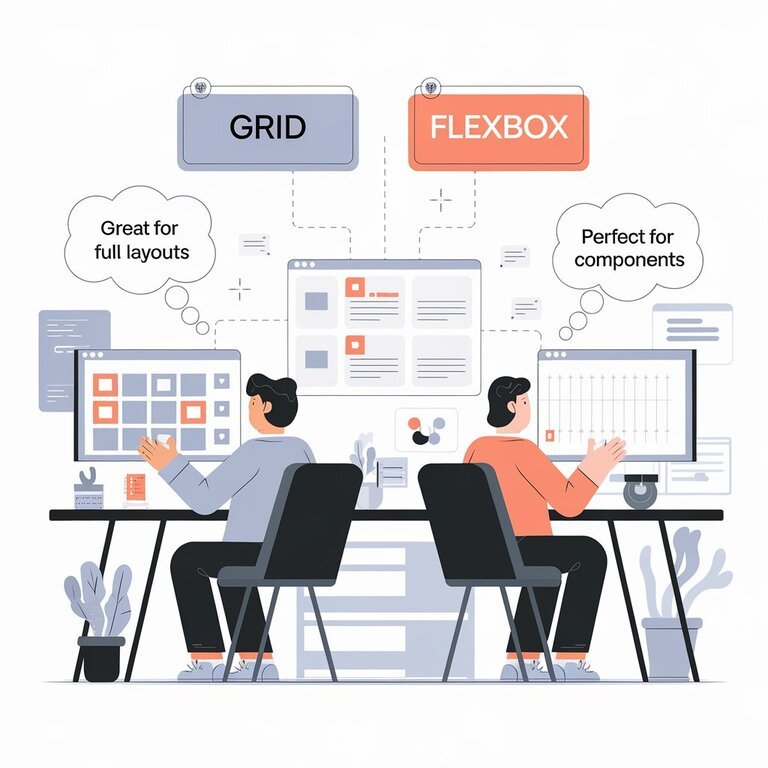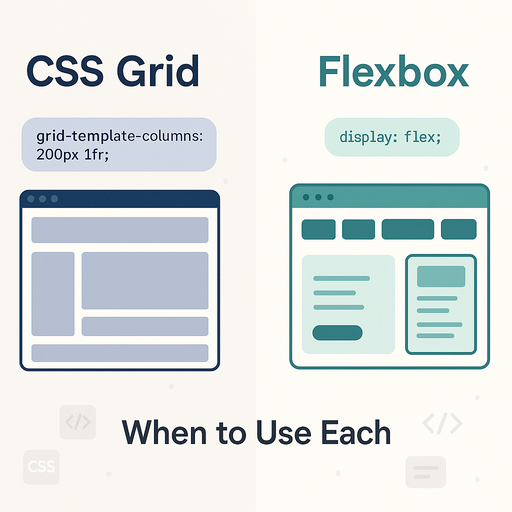
The fundamental distinction between CSS Grid and Flexbox lies in their dimensional capabilities and intended purposes. CSS Grid is a two-dimensional layout system that allows precise control over both rows and columns simultaneously, while Flexbox is a one-dimensional layout system that excels at arranging items along a single axis—either horizontally or vertically.
This dimensional difference makes CSS Grid ideal for complex, structured layouts where you need to control the positioning of elements in multiple directions, while Flexbox shines for component-level arrangements and content distribution along a single direction.
CSS Grid excels when you need to create complex, two-dimensional layouts with precise control over positioning. It’s particularly well-suited for:
CSS Grid follows a layout-driven approach where you define the structure first, then place content within it. This makes it ideal when you have a predetermined design structure and need elements to fit specific grid areas regardless of their content size.
CSS Grid can create responsive layouts with minimal media queries using features like
auto-fit, minmax(),
and fractional units. This allows for algorithmic responsiveness where the layout adapts automatically to different screen sizes.
/* Complex page layout */
.page-layout {
display: grid;
grid-template-areas:
"header header header"
"sidebar main aside"
"footer footer footer";
grid-template-columns: 200px 1fr 150px;
grid-template-rows: auto 1fr auto;
gap: 20px;
}
/* Responsive photo gallery */
.gallery {
display: grid;
grid-template-columns: repeat(auto-fill, minmax(200px, 1fr));
gap: 16px;
}

Flexbox is perfect for single-axis layouts where you need to arrange items in a row or column. Common use cases include:
Flexbox follows a content-driven approach where the layout adapts to the size and nature of the content. This makes it ideal when content size varies and you want the layout to respond dynamically.
Flexbox provides powerful alignment capabilities with properties like
justify-content:center;
align-items: center;
flex-grow: 1;
It excels at:
/* Navigation bar */
.navbar {
display: flex;
justify-content: space-between;
align-items: center;
padding: 1rem;
}
/* Centering content */
.center-container {
display: flex;
justify-content: center;
align-items: center;
height: 100vh;
}
/* Flexible card layout */
.card-container {
display: flex;
flex-wrap: wrap;
gap: 1rem;
}
.card {
flex: 1 1 300px; /* grow, shrink, basis */ min-width: 300px;
}
CSS Grid generally performs better for complex layouts due to its two-dimensional nature, which reduces the need for nested containers. For simple layouts, Flexbox typically renders faster due to its lighter computational requirements.
Modern browsers handle both CSS Grid and Flexbox efficiently, with Chrome consistently outperforming other browsers in rendering both systems. However, the performance difference becomes more noticeable with complex layouts containing many elements.
Flexbox generally uses less memory for simple, one-dimensional layouts, while CSS Grid may consume more memory due to its two-dimensional calculations. For optimal performance, use the appropriate tool for each specific layout requirement.

The most effective approach often involves using both systems together, leveraging their respective strengths:
This hybrid approach maximizes the benefits of both systems while minimizing their individual limitations.
When choosing between CSS Grid and Flexbox, consider these key questions\:
By understanding these fundamental differences and use cases, you can make informed decisions about when to use CSS Grid versus Flexbox, creating more effective and maintainable web layouts that serve both your design goals and user experience requirements.






Ghulam Ahmad is an Excellent Writer, His magical words added value in growth of our life. Highly Recommended
- Irfan Ahmad Tweet
3 Responses
Nice man very interesting post very knowledgeable I like it